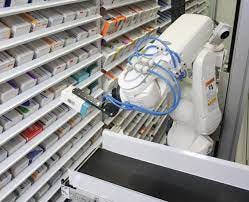Pharmacy Automation Systems are computerized systems designed to automate various tasks performed in a pharmacy setting, including dispensing medications, preparing and packaging prescriptions, and managing inventory. These systems aim to improve the accuracy, efficiency, and safety of the pharmacy operations, and help reduce errors and increase patient safety.
The global pharmacy automation system market size was valued at $5001 million in 2020, and is assessed to reach $11211 million by 2030, growing at a CAGR of 8.3% from 2021 to 2030.

Some common components of a pharmacy automation system include:
- Medication dispensing robots: Automated machines that dispense medication directly into prescription bottles.
- Carousel systems: Rotating storage systems that store medications and dispense them as needed.
- Barcode scanning systems: Technology that allows pharmacists to scan a barcode on a medication bottle to verify its contents.
- Medication packaging systems: Automated machines that package medications into blister packs or other types of packaging.
- Inventory management systems: Software that helps pharmacists keep track of medication stock levels and automatically reorder medications when supplies run low.
Pharmacy Automation Systems have the potential to significantly improve the quality and safety of care provided to patients, as well as increase the efficiency and productivity of pharmacies. However, the cost of purchasing and implementing these systems can be significant, and it’s important for pharmacies to carefully consider the costs and benefits before investing in these systems.
Pharmacy Automation Systems are used in various segments of the healthcare industry, including:
- Retail pharmacies: Large chain and independent retail pharmacies use automation systems to streamline their operations and improve the speed and accuracy of dispensing medications to patients.
- Hospital pharmacies: Hospital pharmacies use automation systems to manage the complex needs of inpatient populations, including dispensing medications, preparing IV admixtures, and managing medication administration records.
- Long-term care pharmacies: Automation systems are used by long-term care pharmacies to manage the unique needs of the elderly and chronically ill patient populations, including medication management and medication administration record-keeping.
- Mail-order pharmacies: Mail-order pharmacies use automation systems to manage the high volume of prescription orders received and to streamline the dispensing and shipping process.
- Specialty pharmacies: Specialty pharmacies, which focus on dispensing high-cost medications for complex or chronic conditions, use automation systems to manage the unique needs of their patients, including managing prior authorization and patient assistance programs.
These segments use Pharmacy Automation Systems to improve efficiency, reduce errors, and enhance patient safety. The specific components used in each segment may vary based on the needs of the pharmacy, but the overall goal is to automate manual processes and improve the quality and safety of care provided to patients.
The future of Pharmacy Automation Systems looks promising, as the demand for these systems is expected to grow in the coming years due to several factors, including:
- Aging population: The growing aging population is expected to increase the demand for prescription medications, leading to a need for more efficient and accurate dispensing systems in pharmacies.
- Increase in chronic conditions: The rise in chronic conditions, such as diabetes and heart disease, is expected to increase the demand for prescription medications and the need for automation systems in pharmacies.
- Growing emphasis on patient safety: The growing emphasis on patient safety, particularly in preventing medication errors, is driving the adoption of pharmacy automation systems.
- Advancements in technology: The continuous advancements in technology are expected to lead to the development of more advanced and sophisticated automation systems in the future.
- Government regulations: Government regulations and initiatives aimed at improving patient safety and reducing medication errors are expected to drive the growth of the pharmacy automation systems market.
Overall, the future of pharmacy automation systems looks bright, with a growing demand for these systems driven by the need to improve efficiency, reduce errors, and enhance patient safety in pharmacies.
0 Comments